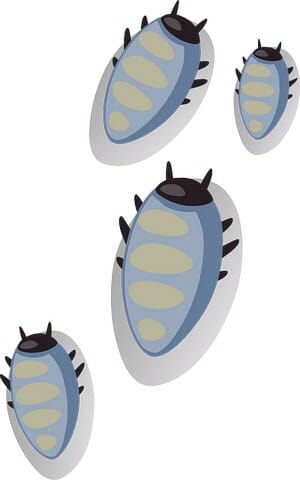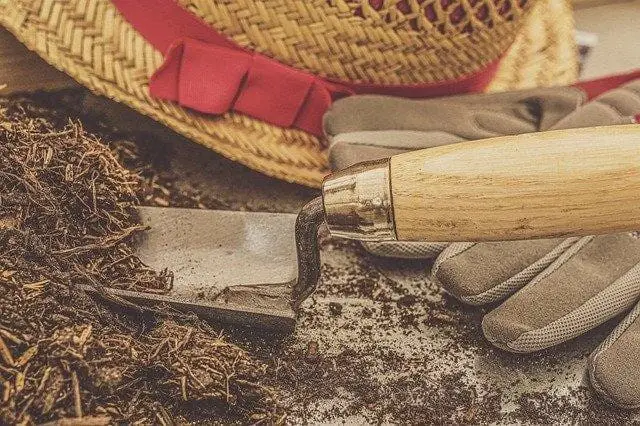Last Updated on June 15, 2023 by Grow with Bovees

If you look at the potted plants in your home closely, sometimes, you may notice tiny white bugs about the size of a pinhead moving on the top of the soil or along the edges of the pot and or compost heap. These tiny creatures could be an indication that you have a soil mite infestation.
While, in general, these tiny white bugs are harmless to the soil and the plants, they are pests and their existence in your precious plants may bother you.
So, if you want to eliminate and kill mites, there are many ways in which you can do that. Continue on for some valuable tips and general gardening information on how to get rid of soil mites.
How To Get Rid Of Soil Mites in Indoor Plants

Mites are beneficial arthropods with decomposition properties that usually make their home in potting soil of potted plants, compost heaps or in a compost bin. They love compost because they are attracted to organic decaying matter such as decaying leaves, moss, wood, peat moss etc. They are most commonly found in wooded areas.
Dirt mites can travel from your outdoor garden spaces to potting soil of indoor plants and move around in your home, patio, etc. and also make their home in your indoor potted plants.
In general, mites are not harmful and are actually considered to be beneficial to the soil as they are a big part of the decomposition process and scavenge on tiny dead insects and fungi. However, they can be a nuisance and are not a pleasant sight to see in your garden soil or house plants.
While there is no evidence that soil mites bite or attack humans, these critters may carry parasites such as the eggs of tapeworms, which can be dangerous and a health hazard to humans. This may lead to you wanting to kill soil mites.
Since mites feed on decaying organic matter, once they run out of food, they will leave and find a new compost pile to call home on their own.
Nevertheless, if you are concerned about these pests being a threat to your health, then it’s better to be safe and get rid of soil mites when you notice an infestation in your plant container or compost bins.
Here is how to get rid of soil mites;
Remove Decaying Organic Matter & Old Potting Soil From Container Plants

Soil mites thrive on decaying matter and so, checking the soil and removing dead leaves on top of the soil, and any decaying material from the soil is the first step to getting rid of soil mites.
Remove a few inches of the top portion of the soil and replace it with fresh, top-quality soil. Check the old dirt you have removed from the pot and remove anything that may serve as food for the bugs.
Re-Pot the Plants In Healthy Soil
Once you have removed the old soil and checked the pot, you can re-pot the plants with new fresh soil. Remove the dead or yellowing leaves immediately as they fall because they may provide a new home for the soil mites.
You can also separate the decaying leaves and matter from the soil and reuse the sifted soil for repotting your plant, if you do not wish to use new soil.
Spray the Plants and Soil
To ensure that the soil is no longer conducive to the soil mites and stop them from coming back, you should spray the dirt, as well as the plants. You can do this by using store-bought chemical pesticides and insecticides containing pyrethrin, or you can make your own organic spray. By doing this, you will also be getting rid of any fungus gnat larvae that are present.
Some great pest control organic sprays that you can make at home very easily are:
Garlic Spray
Put 3-4 cloves of garlic in 1 gallon (3.79 l) of pure water and leave it for 3-4 days. Mix in more water in this solution, add this garlic water to a spray bottle and spray it on the base of the plants and the soil.
Cinnamon Solution
To 4 cups (0.95 l) of water add 1 teaspoon of cinnamon and allow the cinnamon to settle. Pouring this cinnamon mixture on the soil can help to get rid of soil mites and other bugs attracted to decaying matter.
Dishwash Soap & Starch Solution
Mix 3-4 drops of dish soap to 4-5 tbsp of starch and mix this with water. Spray the dish soap solution onto the soil directly. Avoid spraying the dish soap solution on any part of the plant.
Maintain Your Garden
Once you remove the tiny white bugs, it is important to maintain your garden and potted plants to prevent the mites from returning. Remove all the fallen leaves from your garden to prevent them from decaying on the grass. The white soil mites love leaf litter!
If you have a compost pile or tumbler, make sure that it is in an area away from the garden. And, before you repot your plants, spray the ground. This can help to prevent the soil mites from coming into the soil.
Soil Mites vs Spider Mites – What Is the Difference?
Soil Mites
Soil mites are categorized under arthropods. They don’t have internal bones and their legs emerge from their body segments. They live in moist and damp soil and feed on algae, dead plants, dead insects, tiny worms and fungi.
Less than a millimeter in length, a soil mite is very tiny and may be difficult to spot with your naked eye and you can see them as tiny white or brown spots moving on the soil.
The most common type of soil mite is the oribatid mite. These are round mites that have hard shells or exoskeletons and are also known as beetle or turtle mites.
Since the oribatid mite is found in lichen or moss, they are also sometimes called moss mites. Oribatid mites have a long lifespan and can live up to 3-4 years and sometimes even for 7 years.
Some other types are:
- Astigmata Mites: These are usually found in nitrogen-rich soils.
- Gosamid Mites: These are predatory mites and usually flat and light brown in color.
- Mesostigmata Mites: These predatory mites feed on small dead animals.
- Prostigmata Mites: These are a suborder of mites that feed differently.
Spider Mites
Spider mites are actually arachnids, related to the spider. Spider mites are around 1 mm in length with pale white to brown bodies and 8 legs. These tiny indoor garden pests are not easy to see with the naked eye when it infests a plant.
These pests can cause serious damage to your garden and plants and a large infestation of spider mites can damage the leaves of plants, which start developing small, dark reddish spots, and you should therefore be sure to get rid of them.
Spider mite infestation is also characterized by the appearance of fine spider webs appearing on the plant.
Are Soil Mites Harmful to Houseplants?

While these critters are not harmful to houseplants as such, they can be a problem when they enter your home because they can be dangerous to humans. They are known to carry bacteria that cause diseases. Moreover, these bugs can act as hosts and carry the eggs of tapeworms, so you might want to get rid of them after all.
So, a plant with a soil mite infestation can expose you and your family to bacterial infections or tapeworms that these bugs may carry. So, it is a good idea to eliminate soil mites from the soil in your potted plants immediately. By using the best soil for indoor plants, you will get off to a good start.
What Harm May Soil Mites Cause to Outdoor Plants?
Soil mites can be more a friend than an enemy when it comes to shrubs outdoors. They are not harmful to outdoor plants or the dirt. In fact, they play an active role in the decomposition of organic matter in the topsoil, making it easier for the plant to absorb the nutrients from the ground.
These bugs also help to manually aerate the soil, making it easier for the water to penetrate the soil, ensuring that the soil has sufficient moisture.
In fact, soil mites in your outdoor soil can be considered a good sign that your soil is healthy and is ideal for your plants.
Benefits and Dangers of Soil Mites

While soil mites may be considered pests by most people, according to agricultural experts and scientists, these are considered to play quite an important role in improving soil health.
Let’s look at the benefits and dangers of these critters;
Benefits
- They help in the decaying process of organic matter, which not only helps to improve the health of the soil but also improves the ability of the plants’ roots to absorb the nutrients more effectively.
- Known as essential nematodes, soil mites indicate that your soil is healthy.
- They help your plant to survive.
Dangers
- They are considered to be pests and an infestation can be a nuisance.
- They can carry disease-causing bacteria and transmit diseases to humans.
- They carry eggs of parasites such as tapeworms, which are transmitted to humans.
Wrapping Up
This concludes our article on how to get rid of soil mites and while these white bugs are often considered pests, they are also seen as helping the soil and ecosystem. So, if you’re not troubled by these critters, then you can let them be because when they run out of food, they too will depart to find new homes.
However, if you want to get rid of them, then you can use any of the methods we have discussed in our article. Other products that one can use include hydrogen peroxide and neem oil. Nevertheless, whatever method you decide to use, your top priority should be the health of your soil and plants.
